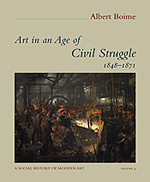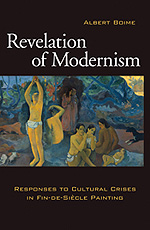The browser will either open the file, download it, or display a dialog.
|
Albert Boime Art in an Age of Civil Struggle, 1848-1871 Revelation of Modernism: Responses to Cultural Crises in Fin-de-Siècle Painting |
||||||
|
As wide-ranging as Albert Boime’s scholarly legacy is, his contributions to the history of nineteenth-century art are especially noteworthy. Two recent publications exemplify the distinctive methodological commitments as well as the expansive intellectual ambition for which he was justly renowned. Art in an Age of Civil Struggle, 1848-1871 is the fourth volume of the monumental Social History of Modern Art series that Boime began in 1990 and includes chapters on Realism, the Pre-Raphaelites, the Macchiaioli, Biedermeier culture, American visual responses to slavery and frontier expansion, France’s Second Empire, and aesthetic responses to the Franco-Prussian War. As the title of the series indicates, his methodology here is consistent with the materialist views he maintained throughout his career. Derived from Marxist modes of analysis, Boime’s approach focuses on the means of cultural production. This emphasis leads him not only to consider the economic and political forces underlying artistic production, but the material and ideological circumstances motivating artists as well. Artists, in Boime’s formulation, are laborers: their lives and ideas require the same consideration he would give to any other part of the economic base. Biography, then, plays a particularly strong role in Boime’s narration of cultural history, and Art in an Age of Civil Struggle is largely structured around the lives of a handful of artists whose responses to the revolutionary year of 1848 reveal something akin to class consciousness. |
|||||||
|
Most of the artists discussed by Boime, by virtue of a heightened sensitivity or responsiveness to contemporary ideological pressures, execute artworks remarkable for their prescience. The list of artists capable of exposing the ideological implications of 1848 is familiar, and Boime includes in Art in an Age of Civil Struggle much of his earlier writing on Thomas Couture, Gustave Courbet, Edouard Manet, John Everett Millais, William Holman Hunt, Ford Madox Brown, Adolf Menzel, Alfred Rethel, and Lilly Martin Spencer, among others. Not all of these artists possess the capacity to transcend dominant ideological investments. Spencer, for instance, replicates racist stereotypes even as she creates what she imagines to be sympathetic images of African Americans. Rethel, whose woodcut series Auch ein Todtentanz manifests the reactionary and anti-Semitic attitudes that shaped Bismarck’s German Empire, demonstrates how an artist committed to “conservative and counter-revolutionary” politics can generate imagery just as redolent of class struggle as anything produced by the left. |
|||||||
|
Boime’s reliance on biography, though, occasionally places him in an awkward spot, especially when an artist’s work does not align so neatly with his apparent political investments. Menzel proves the greatest disappointment. The artist’s correspondence reveals him to be politically cautious and sympathetic to Prussia’s conservative government. In Berlin during the bloody insurrection of March 18-19, 1848, Menzel later wrote of the events to a friend. This letter, Boime complains, “reeks with ambiguity and ambivalence about the revolution” (560). The artist’s observation that “many barricades were finally taken by storm, but only at great cost in human lives, especially the officers” provokes Boime to incredulity. “It is difficult to understand how ‘Menzel the Realist’ could have uttered it” (562-63). Nowhere is mention made of the 183 civilians who were killed in these clashes; Menzel instead expresses regret at the comparatively light loss of twenty soldiers. The issue here has as much to do with Boime’s understanding of realism as with Menzel’s politics. Earlier in Art in an Age of Civil Struggle, Boime had linked aesthetic realism with social self-consciousness: “Realism implies the absence of idealism and a felt duty to carefully trace the sources of the conditions of existence” (76). Yet Menzel, a consummate realist, appears willfully blind to the ideological truths of Prussia in 1848. His painting of the Public Funeral of the Victims of the March Revolution (1848) likewise minimizes both the human cost and the success of the insurrection, which had forced the government to withdraw its troops from the city and stage an elaborate ceremony in honor of those killed at the barricades. The painting, Boime states, “could not seem more dispassionate” (566). |
|||||||
|
To square Menzel’s earnest, authentic realism (in contrast to the contrived and hollow “official realism” propagated under Napoleon III) with his apparent sympathy for the government of Wilhelm I, Boime takes recourse to psychoanalytic theory, a maneuver deployed frequently in Art in an Age of Civil Struggle. The artist’s pronounced identification with his father, whose early death left the sixteen-year-old Menzel to take charge of both his father’s lithography business and his family, led the young man to unconsciously find in Wilhelm a replacement for the lost parent. Coupled to this, Boime asserts, was Menzel’s “habituation to death” after the loss of several close family members, which led to the “emotional detachment” of works like Public Funeral of the Victims of the March Revolution. Thus Menzel’s realism, despite its pictorial clarity and anodyne themes, is a product of psychological defense mechanisms rather than ideological clairvoyance. In his chapter on Manet, Boime accords a similar reading to that artist’s sympathetic rendering of Mexico’s deposed Habsburg emperor in his Execution of Emperor Maximilian (1867-68). Simultaneously serving as both psychic alter-ego and unconscious rival to the artist, “Maximilian could only have aroused in Manet ambivalent emotions of love and envy, admiration and vindictiveness...The image of Maximilian courageously confronting his annihilators is the heroic dream-projection of Manet himself” (731). |
|||||||
|
As much as his emphasis on psycho-biography threatens to undermine Boime’s essential commitment to materialism, it does provide a series of welcome narrative threads through his occasionally protracted discussions of, for instance, the history of social utopianism of Garibaldi’s world travels (as colorful as they are) or the machinations of the Prussian Constituent Assembly. Boime’s awareness of the tension inherent in his attempt to marry materialist analysis with biography is conveyed in the preface to Revelation of Modernism: Responses to Cultural Crises in Fin-de-Siècle Painting where he avers that “If on occasion I view the works as imbricated in the artist’s personal problems, my emphasis on the image is always as an ideological construction that moves beyond authorial intentionality” (xi). The first essay in Revelation of Modernism, which, like Art in an Age of Civil Struggle, includes some previously published material, supports Boime’s claim that he is not in the thrall of artistic personalities. “Van Gogh’s Starry, Starry Night: After the Apocalypse a Heavenly Utopia,” refutes earlier readings of the sparkling nightscape as a representation of one of the artist’s fantastical, psychosis-fueled visions. Instead, Boime draws on the work of contemporary astronomers to argue that Starry Night was the record of the night sky more or less exactly as it appeared over Arles during September of 1888. |
|||||||
|
Likewise, the second chapter in Revelation of Modernism which comprises four essays and a brief conclusion, suppresses the emotional in favor of the political. Seurat’s La parade de cirque (1888), Boime argues convincingly, should be understood as a bitter allegory of the political campaign of the General Boulanger with its raucous rallies and curious admixture of royalist and republican tenets. The psychoanalytic impulse returns, however, in the essay on Cézanne, whose hermetic representations of the landscape around his home in Aix testify to the artist’s emotional isolation and social conservatism. Linking the formal structure of Cézanne’s landscapes to the imperial policies of France, Boime asserts that the painter “hoped to realize a beneficent control of the earth that would secure the peculiar harmony and moral supremacy that he envisioned in his approach to landscape” (133). The irony that Cézanne’s famously avant-garde technique was developed in furtherance of conservative political and religious ideals is not lost on Boime, who discerns a similar disjuncture between Gauguin’s social views and his artistic practice. |
|||||||
|
The final, and lengthiest, essay in Revelation of Modernism addresses Gauguin’s Where Do We Come From? What Are We? Where Are We Going? (1897), which Boime contends is a meditation on the occult philosophy of the nineteenth-century mystic Eliphas Lévi. Though Boime confesses that the artist never mentions Lévi in his letters or other writings, compelling correspondences in their work lead him to assert that “Lévi’s [ideas] provide the key to unraveling the mystery of Gauguin’s ambitious statement in paint” (199). The allure of mysticism, especially the Christian mysticism espoused by Lévi, was, Boime contends, a fundamentally conservative impulse shared by Europeans suspicious of social as well as technological progress. Boime points to Gauguin’s well documented racism and anti-Semitism as evidence of the artist’s essentially conservative sympathies, leading him to conclude that “Gauguin’s primitivism...proved to be inseparable from his ethnic prejudices and contributed to the arsenal of the antimodernists who turned modernism into an ideological weapon against democratic society” (220). Like the coda with which Boime ends Art in an Age of Civil Struggle, the brief conclusion to Revelation of Modernism trains an unblinking eye on the anti-Semitism held so widely by members of the European artistic avant-garde but so rarely discussed by art historians. Whether deliberate or unconscious, this scholarly silence, Boime warns, has the same terrible consequences. “The pioneer modernists imagined that they were providing a fresh visual paradigm not only for cultural insiders but for their society generally, one that would radicalize people’s worldview and lead to actual social change” (221). This self-delusion was, perhaps, even more ideologically dangerous than the forthright imperialism or conservatism promulgated by official arts organizations. “The urge to go primitive,” Boime concludes, “actually meant the liberty to unleash the murderous instincts that the white race attributed to the peoples it attempted to subdue. Thus the road to modernism was paved with the contradictions inherent in the notion of the law of progress” (222). Coming from a scholar who devoted much of his intellectual energy to avant-garde visual culture, the thoughts with which he concludes both books are sobering indeed. |
|||||||
|
Together, these two volumes can be taken together as representative of Boime’s work on nineteenth-century art history. Though Art in an Age of Civil Struggle is a bit unwieldy for use as an undergraduate textbook, scholars and graduate students will find it a handy reference, especially for its information on European and British art of the 1840s through 1860s. The chapter on American art is rather lean and readers would be better served in returning to Boime’s The Magisterial Gaze (1991) and The Art of Exclusion (1990), from which this chapter is largely condensed. Revelation of Modernism likewise provides a useful compendium of Boime’s thinking, and could be used in undergraduate or graduate courses that deal with late nineteenth-century French painting. |
|||||||
|
Elizabeth Mansfield |
|||||||
| © 2009-10 Nineteenth-Century Art Worldwide and Elizabeth Mansfield. All Rights Reserved. |




